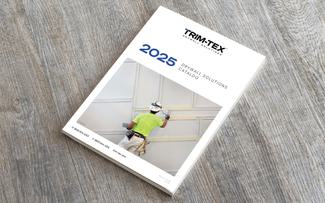Originally, the choice to switch from metal corner bead to vinyl wasn’t actually Juan’s to make — the drywall contractor he works with, Construxus, made that call, as the skyrocketing price of steel made Trim-Tex’s vinyl beads the more affordable option. But now that Juan’s made the leap, he isn’t looking back.
Why This Residential Drywall Contractor Switched to Vinyl Corner Bead

We met Juan at a luxury two-story house under construction in Lemont, Ill., within a lovely, treelined community called Estates of Montefiori. In this developing subdivision, single-family homes like this one are being constructed about as fast as they can be sold. So, for drywall contractors like Construxus, every single scrap of material counts, and whatever Juan doesn’t use in this house can be used in the next one just down the street. If a stick or whole box of corner bead gets dinged (and they do, often before they even make it onto the drywall), that’s not just a setback — it’s time and money thrown out the window, not to mention more hard work for Juan.
When Juan got his hands on vinyl corner bead and saw how resilient it was, he instantly saw how valuable that could be: a residential job like this one can get done with way less hassle and with way less waste.

As Juan describes in the video above, when metal corner bead fails, there’s no putting Humpty Dumpty back together again: “When they failed, they crack, they go in the garbage, and it’s like $300 per carton,” says the finisher. Vinyl corner bead, on the other hand, is far more durable and adaptable; it can withstand a whole lot of impact and spring right back into shape. Plus, it’s just easier stuff to work with — vinyl beads are “easy to put on, easy to work with, easy to cut,” according to Juan.
Vinyl solutions go far beyond your basic 90-degree corners. Just in this one home, in addition to the standard Corner Bead & Archway, you’ll find a variety of beads to solve a variety of problems. Here, expertly sprayed and stapled into place by Juan and his brother, they used:
Rigid Closed Angle

Closed Angle bead was chosen for most of the corners in the house. The big difference with the Rigid Closed Angle Corner Bead is its 81-degree angle, as opposed to the standard 90 degrees.
This makes the bead particularly useful when your framing is less than perfect, but it also gives it a feeling of increased rigidity that makes the vinyl bead behave more like a metal one (with none of metal’s many drawbacks). For this reason, many finishers who have used metal bead for years, like Juan, have found it to be an ideal choice when starting to transition to using vinyl. Learn more about how Closed Angle is a great metal alternative here.
Splayed Corner Bead

They used this solution to quickly finish outside corners with obtuse off-angles, which were found all over this house’s ceilings.
Flat Tear Away L Bead

The crew here used Flat Tear Away around all the windows in the house. This bead is used when the drywall is butted too close to windows like these to slip a return leg behind it, or when you’ve added backing materials between the window and the drywall. All in all, it made the job of finishing all these windows far cleaner and easier.
For each of these solutions, Juan and his brother make the job look easy, flying through this house to move on to the next one. If you’re still using metal corner bead, hit the button below to get a free copy of the Trim-Tex catalog, and browse through the many solutions we’ve got for all kinds of drywall finishing problems. Make the switch to vinyl. Like Juan and Construxus, you won’t look back.

Find Your Next Solution
Request your copy of the latest Trim-Tex catalog, available in either print or digital editions
